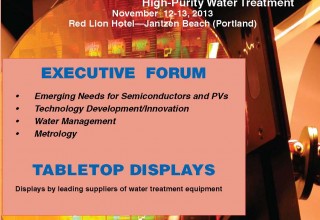2013 Ultrapure Water Micro To Feature Four Sessions
ULTRAPURE WATER Micro 2013 will be conducted Nov. 12-13, 2013 in Portland, OR. Registration is open for the conference that will focus on semiconductor water. The conference will have 4 sessions and a panel discussion. Visit www.ultrapurewater.com
Online, October 9, 2013 (Newswire.com) - The 2013 ULTRAPURE WATER Micro conference will feature four sessions focused on key areas of successful semiconductor water treatment. The Nov. 12-13 session will be conducted at the Red Lion Hotel on Jantzen Beach in Portland.
The meeting will open with Session 1, "Key Business and UPW Technology Trends." Dr. Kyle Flanigan, a director with Linx Consulting LLC, will begin the day with a presentation on "Materials Challenges for Advanced Nodes". He has more than 17 years of experience in advanced materials development. Over the past 10 years, Dr. Flanigan has led development, scale-up, and HVM ramp activities for suppliers to the semiconductor, PV, and LED markets. He joined Linx in 2013 and before that has held positions with Avantor Performance Materials Inc., Intel, and Honeywell Electronic Materials.
Next, Dr. Abbas Rastegar of SEMATECH will address the topic of "Particle Control Challenges in UPW". This presentation will be a continuation on his work on controlling particles in semiconductor water. At the 2012 ULTRAPURE WATER Micro conference in Phoenix, he examined particle challenges for the sub-16 nanometer HP technology node. Dr. Rastegar has more than 20 years of R&D experience. The morning will have three other presentations.
"Innovations with UPW Design and Water Management" is the theme for Session 2 on Tuesday afternoon.
Matthew Weglewski of M&W Group and John Morgan of H2Morgan are coauthors of a presentation entitled, "Designing a UPW System to Optimize for UPW Unit Costs versus Lowest Capital Costs Will Result in a Long-Term Competitive Advantage for the Life of the Plant." Among topics, their paper will evaluate the need to evaluate initial capital investment and operating costs. The authors will provide examples where evaluating operating costs in the equipment selection and system design can improve the ability to produce UPW needed for the fab at a competitive price.
The second afternoon presentation by Ralph Williams and Annabelle Fonseca of CH2M Hill, and Mark Masse of the Genesee County (New York) Economic Development Center will review issues and conclusions for strategic planning of water and wastewater infrastructure for a greenfield semiconductor manufacturing plant being developed for the Western New York Science Technology and Advanced Manufacturing Park. This park is being prepared for nanotechnology-oriented manufacturing projects. Topics be addressed include water and wastewater requirements, expected wastewater qualities, site water supply, wastewater management, and infrastructure needs.
Session 2 will have four other presentations, and then will conclude with a Roundtable discussion on the role of industry collaboration to support next generation semiconductor industry needs.
Session 3 on Wednesday morning, Nov. 13 will examine advances in UPW metrology. The day will start with a presentation on "TOC Screening with LC-OCT: Current Status" by Dr. Stefan Huber of DOC-Labor, and Dr. Slava Libman of Balazs NanoAnalysis. Their paper will examine the use of liquid chromatography with a detector for compound identification as a screening tool for organics in feedwater and UPW.
"The Effect of Particle Concentration and Face Velocity on the Removal of Sub-100-nm Particles from Ultrapure Water" is the title for a presentation by Don Grant and Gary Van Schooneveld of CT Associates, and Uwe Beuscher of WL Gore and Associates.
The paper will examine particles in semiconductor water and the use of micro porous membranes to remove particles from semiconductor water. Traditional assumptions have been that particle capture is largely independent of particle concentration, filter loading, and filter face velocity. However, testing has indicated the retention of sub-100-nm particles often decreases with increasing particle concentration, filter loading, and face velocity. The paper examines the implications of these findings. Session 3 will conclude with 3 other papers on important metrology topics.
Session 4 on Wednesday afternoon will examine "Advanced Materials in UPW Application" with three presentations.
Rosemary Heinze of Arkema Inc. will begin the afternoon with her paper on the history on the use of polyvinylidene fluoride (PVDF) materials in the semiconductor industry. The discussion will center significant learning from the early years that have led to the current PVDF product offerings for fluid handling systems. The author's goal is to explain how current products have improved to meet changes needed by the water treatment business.
The session will also have two other presentations: 1. "Why Are Fluoropolymers the Best Choice for UPW Distribution Systems?" by Giovanni Biressi, Ph.D., Brigitte Neubauer, Ph.D., and Kris Haggard, Solvay Specialty Polymers; and 2. "A Study of the Effect of Elastomeric Seals Exposed to Ozone" by Katrin Wallheinke, Wolfgang Paul and Jeffrey Sixsmith, Georg Fischer Piping Systems; Casey Williamson, SEMTEC, Inc.; and Marty Burkhart, Hi Pure Tech, Inc.
In addition to the technical papers, ULTRAPURE WATER Micro 2013 will include tabletop exhibits by key suppliers of products and services used in water treatment for microelectronics applications.
Additional Information
ULTRAPURE WATER Micro 2013 is sponsored by Tall Oaks Publishing, which also publishes ULTRAPURE WATER journal and INDUSTRIAL WATER TREATMENT magazine. Conference updates and registration information are available at www.talloaks.com or by calling 303/973-6700.

